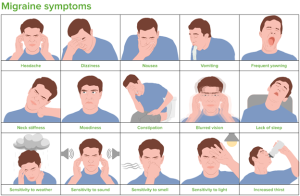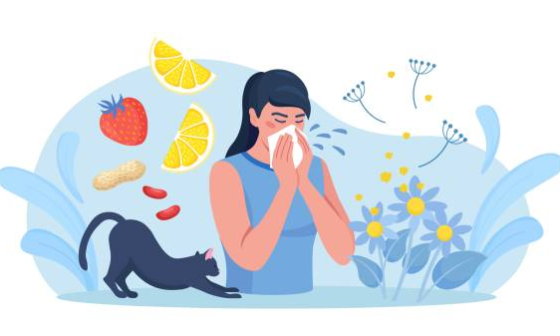Introduction
Headaches are popular symptoms of many types of neurological issues. For many people who suffer from different kinds of headache disorders, migraines are usually the culprit. Due to its popularity, this article aims to explain what migraines are, their symptoms, causes, and why health coverage matters in managing migraine headaches.

Credit: Deposit photos
What is a Migraine?
Migraine is a chronic, crippling neurological ailment that affects over 5 persons in 100 people (5 per 100 in men and 6 per 100 in women) living in Nigeria. According to research, migraine headaches peak in the first ten years of life for both sexes and in the second and third decades, the prevalence of migraine headaches was three times higher in women than in men.
A migraine is a neurological disorder characterized by intense headaches that are throbbing and occur frequently, usually on one side of the head, with a wide range of other symptoms can persist for hours or even days. In contrast to regular headaches, migraines frequently cause other symptoms such as light and motion sensitivity, nausea, and vomiting.
Migraines occur frequently because of their chronicity and how they can impact the quality of your life. There are four stages migraines typically go through, however, not everyone will experience them all:
- Prodrome: A person may have mild symptoms such as mood fluctuations, food cravings, stiff neck, or exhaustion hours or days before a migraine.
- Aura: A few people report having tingling, blind spots, or light flashes as examples of sensory abnormalities. This phase comes before the headache and typically lasts less than an hour.
- Attack: The period of acute, throbbing headache pain, which is exacerbated by physical activity, can last anywhere from four to seventy-two hours. It is typical to experience nausea and vomiting in addition to sensitivity to light, sound, or odours.
- Postdrome: People frequently experience exhaustion, confusion, and depletion after their migraine has passed. This stage may continue for a few hours or perhaps a whole day.
Migraine Risk Factors
Certain factors may increase your risk of getting migraine headaches they include:
- Sex: Females are more likely to suffer from migraines than males in the ratio of 3:1
- Age: Younger persons are more likely to come down with migraines, researches have shown that migraine headaches begin between ages 10 – 40, and there is a rapid decline of episodes after menopause.
- Family history: You have a 50% probability of developing these headaches if one parent has a history of them. The chance increases to 75% if both parents have them.
- Medical conditions: Research by the National Institute of Neurological Disorders and Strokes shows that some medical conditions increase your risk for migraine headaches, such as bipolar disorder, depression, anxiety, and epilepsy.
Common Causes/Triggers of Migraine Headaches
Although the precise aetiology of migraines is unknown, a mix of lifestyle, environmental, and hereditary variables frequently play a role.
Typical triggers include:
- Dehydration and diet: Although it’s not the most well-known migraine trigger, dehydration can be one. For dietary causes, a frequently hypothesized group of triggers referred to as the “5 Cs“: citrus fruits, cheese, chocolate, coffee, and cola have been implicated, others are processed meats and red wine. Starvation/ meal skipping might also act as a trigger.
- Stress: Among the most frequent causes of migraines is emotional stress. Any form of tension, including work-related stress and family issues, might trigger a migraine.
- Hormonal changes: Women are more likely to experience migraines, which are frequently related to changes in hormones during menstruation, pregnancy, or menopause.
- Sleep disruptions/ Lack of sleep: Migraines may result from either insufficient or excessive sleep. Retaining a consistent sleep schedule is crucial for those who have migraines.
- Environmental factors: Sudden weather changes, bright lights, loud noises, or strong smells can all trigger a migraine.
- Medication abuse: Using painkillers (analgesics, opioids) or specific drugs (ergots, triptans) excessively might cause medication-overuse headaches, which increase the frequency and intensity of migraine attacks.
Symptoms of Migraines

Credit: Lecturio
A migraine is characterized by intense, throbbing pain, but it can also cause a wide range of additional symptoms that make the illness more complicated than a straightforward headache.
Common signs and symptoms include:
- One-sided severe headache
- Nausea and Vomiting
- Sensitivity to light and sound
- Fatigue
- Aura: Some migraineurs have transient visual abnormalities including zigzag patterns, flashing lights, or loss of vision.
Why Health Coverage Is Crucial in Migraine Management
Migraines are not merely a passing discomfort, migraines are a persistent ailment that can seriously impair day-to-day functioning and productivity. Therefore, for those who have this migraine and other headache disorders, enhancing their quality of life requires effective management and therapy. This is the point at which having comprehensive affordable health plans offered by Wellahealth becomes essential.
Coverage ensures:
- Obtaining specialized care: Expert care from neurologists or headache specialists is frequently necessary for migraine sufferers. The expense of these consultations can be exorbitant if you do not have health coverage.
- Examination for diagnosis: To diagnose migraines, it is necessary to rule out other possible causes of headaches, which frequently calls for diagnostic procedures like CT or MRI scans. When no healthcare plan is present, these tests might be costly. The optimal treatment plan must be determined by a proper diagnosis, and health coverage is essential in providing the funding for these required diagnostic tests.
- Prescription drugs: Drugs are often necessary for migraine sufferers to either avoid attacks or treat symptoms once they occur. Drugs can be; preventive medication and acute episode medications. Health coverage ensures that these frequently expensive treatments don’t become an overwhelming financial burden.
- Preventative care: An important factor in encouraging preventive treatment is health coverage. Early management, lifestyle counselling, and routine checkups can all help reduce the frequency and severity of migraine attacks.
Management: What to do if you have migraines
- Identify and avoid triggers
- Maintain a healthy lifestyle and get enough sleep.
- Remain hydrated
- Eliminate and manage stress and stressors
Conclusion
Migraines are difficult and frequently incapacitating headache disorders that can be effectively manageable with the correct attention and therapy.
Wellahealth recognizes how critical it is to assist you in controlling long-term illnesses like hypertension and diabetes. That is why we provide affordable and accessible healthcare coverage to ensure you live a more comfortable and healthy life with access to the necessary care. Contact us today to subscribe to our health plans for as low as #800/month.
Article written by Dr. Ifeoma M. Uduh (BDS)
Edited by Dr. John Afam-Osemene (MBBS, DA)






